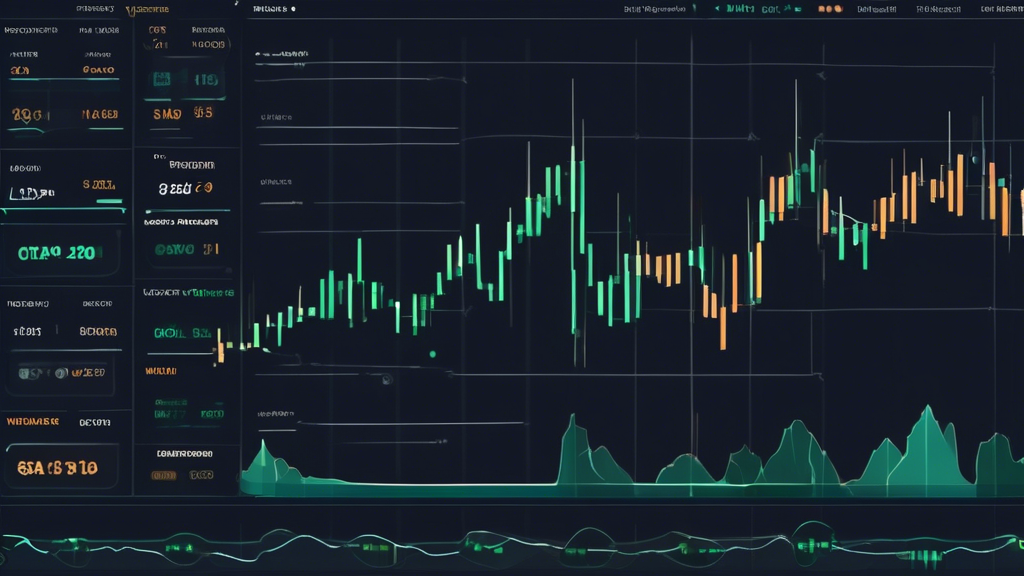Introduction to Crypto Margin Trading What is Crypto Margin Trading? In the rapidly evolving world…
Top Crypto Trading Indicators You Should Know

Understanding crypto trading indicators is crucial for successful cryptocurrency trading. In the volatile and rapidly evolving cryptocurrency market, these indicators serve as essential tools for traders to analyze price movements and make informed decisions. Crypto trading indicators provide valuable insights into market trends, momentum, and potential reversal points, enabling traders to develop strategic approaches and optimize their investment outcomes.
Crypto trading indicators, such as Moving Averages (MAs), Relative Strength Index (RSI), and the Stochastic Oscillator, are among the most commonly used tools by traders. MAs, including Simple Moving Average (SMA) and Exponential Moving Average (EMA), help in identifying trends and smoothing out price data to reveal patterns more clearly. RSI is crucial for spotting overbought and oversold conditions, offering traders signals for potential market entry and exit points. The Stochastic Oscillator is another important tool, aiding in predicting price reversals by comparing a particular closing price to a range of its prices over a specific time period.
Advanced crypto trading indicators like Bollinger Bands and Fibonacci retracement levels provide deeper insights for more experienced traders. Bollinger Bands consist of a moving average and two standard deviations, which help in analyzing market volatility and identifying overbought or oversold conditions. Meanwhile, Fibonacci retracement levels are based on the Fibonacci sequence and are used to predict potential support and resistance levels, offering traders a framework to forecast price movements and plan their trades accordingly.
Choosing the right indicators for your trading strategy is pivotal for optimizing your trading performance. Factors such as your trading style—whether you are a day trader or a long-term investor—current market conditions, and the specific characteristics of the cryptocurrency you are trading should be considered. Combining multiple indicators can also provide a more comprehensive analysis, enhancing the accuracy of your predictions. Practical implementation of these indicators involves consistent monitoring, testing different combinations, and adjusting your strategy to align with market dynamics.
By selecting the appropriate crypto trading indicators based on your strategy, you can significantly enhance your trading performance and make more informed trading decisions.
Introduction to Crypto Trading Indicators
Importance of Crypto Trading Indicators in the Cryptocurrency Market
Understanding crypto trading indicators is crucial for successful cryptocurrency trading. These financial tools play an essential role in a trader’s arsenal, offering insights into market trends, price movements, and potential entry and exit points. Given the volatile nature of cryptocurrencies, having a reliable set of indicators can significantly improve decision-making and enhance profitability.
Brief Overview of How Indicators Help in Making Informed Trading Decisions
- Trend Identification: Trading indicators like Moving Averages (MAs) help identify the direction of the market trend. This enables traders to understand whether the market is in an uptrend, downtrend, or moving sideways.
- Market Momentum: Indicators such as the Relative Strength Index (RSI) measure the speed and change of price movements, assisting traders in gauging market momentum.
- Overbought or Oversold Conditions: Tools like the RSI and the Stochastic Oscillator indicate whether an asset is overbought or oversold, helping traders make decisions about potential price corrections.
- Support and Resistance Levels: Advanced indicators like Fibonacci Retracement Levels help traders identify potential support and resistance levels, guiding entry and exit points.
By incorporating these indicators into their trading strategy, traders can better navigate the complexities of the cryptocurrency market.
Mention of the Keyword
Understanding crypto trading indicators is crucial for successful cryptocurrency trading. They provide valuable insights into market dynamics and can significantly influence trading outcomes. Knowing when to buy or sell based on these indicators can mean the difference between a profitable trade and a loss.

Popular Types of Crypto Trading Indicators
Moving Averages (MAs)
Moving Averages are among the most commonly used crypto trading indicators and come in different types, with the Simple Moving Average (SMA) and Exponential Moving Average (EMA) being the most popular.
- Simple Moving Average (SMA): This type of moving average calculates the average of a selected range of prices by the number of periods within that range. The SMA is helpful in smoothing out price data to identify the direction of the trend over a longer period.
- Exponential Moving Average (EMA): Unlike SMA, the EMA gives more weight to the most recent prices, making it more responsive to new information. This responsiveness makes it particularly useful for short-term trading.
Moving Averages help traders identify trends by providing a smoothed line that makes it easier to see price direction over time. By comparing the current price to the moving average, traders can determine whether a cryptocurrency is likely in an uptrend or downtrend.
Relative Strength Index (RSI)
The Relative Strength Index (RSI) is another widely used crypto trading indicator that measures the speed and change of price movements. It is typically used to identify overbought or oversold conditions of an asset.
- Definition: RSI is a momentum oscillator that ranges from 0 to 100. Traditional usage dictates that an RSI above 70 indicates an overbought condition, while an RSI under 30 suggests an oversold condition.
- Importance: The RSI helps traders identify potential entry and exit points. For example, an RSI over 70 may be a signal to sell, while an RSI below 30 might indicate a buying opportunity.
Using RSI allows traders to spot divergence, which happens when the price moves in the opposite direction of the RSI, potentially signaling a trend reversal.
Stochastic Oscillator
The Stochastic Oscillator is a momentum indicator comparing a particular closing price of a cryptocurrency to a range of its prices over a certain period.
- Basic Concept: The Stochastic Oscillator ranges from 0 to 100. Values above 80 usually indicate an overbought condition, while values below 20 suggest an oversold condition.
- Usage: This indicator helps traders predict price reversals by identifying the momentum changes of an asset. For instance, when the indicator moves below 20 and then rises above it, it might be a buy signal. Conversely, when it moves above 80 and then drops below it, it might be a sell signal.
The importance of the Stochastic Oscillator lies in its ability to provide signals about the momentum and potential price direction changes, making it invaluable for short-term trading strategies.
These are among the most commonly used and significant crypto trading indicators, including Moving Averages, RSI, and the Stochastic Oscillator, which help traders make more informed decisions in the volatile cryptocurrency market.
For further reading on these indicators, refer to:
Investopedia on Moving Averages
Investopedia on Relative Strength Index
Investopedia on Stochastic Oscillator

Advanced Crypto Trading Indicators
Bollinger Bands
Bollinger Bands are a versatile and popular technical analysis tool used by traders to measure market volatility and identify potential buy and sell opportunities. Developed by John Bollinger in the 1980s, Bollinger Bands consist of three lines:
- Upper Band: Typically set two standard deviations above the simple moving average (SMA).
- Middle Band: A simple moving average (usually 20 periods).
- Lower Band: Typically set two standard deviations below the simple moving average.
The distance between the upper and lower bands reflects market volatility. When the bands are close together, it indicates low volatility, while wider bands suggest higher volatility. Traders use the bands to identify overbought and oversold conditions:
- Overbought: When the price touches or exceeds the upper band, the asset is considered overbought, which may signal a potential sell opportunity.
- Oversold: When the price touches or falls below the lower band, the asset is considered oversold, which may signal a potential buy opportunity.
Understanding and utilizing Bollinger Bands can help traders make more informed decisions by analyzing price movements and their relation to market volatility. For more in-depth information on Bollinger Bands, you may visit Investopedia’s Bollinger Bands page.
Fibonacci Retracement Levels
Fibonacci retracement levels are a popular tool used by traders to identify potential support and resistance levels in the market. These levels are based on the Fibonacci sequence, a series of numbers in which each number is the sum of the two preceding numbers. The key Fibonacci retracement levels are:
- 23.6%
- 38.2%
- 50%
- 61.8%
- 78.6%
Traders apply these levels to a price chart to identify potential reversal points. Here’s how they work:
- Uptrend: During an uptrend, traders might look for price retracement levels, expecting the price to potentially reverse upward again at one of the Fibonacci levels after a pullback.
- Downtrend: During a downtrend, traders might look for price retracement levels, expecting the price to potentially reverse downward again at one of the Fibonacci levels after a price rally.
For example, if an asset price rises from $100 to $200, a trader might apply Fibonacci retracement levels to the price range ($100 – $200) to predict potential support levels at 23.6%, 38.2%, 50%, 61.8%, and 78.6% retracement of the rise.
Using Fibonacci retracement levels can help traders anticipate potential price reversals and plan their entry and exit points more effectively. To explore further on this topic, you can read Investopedia’s explanation of Fibonacci retracement.
Advanced crypto trading indicators like Bollinger Bands and Fibonacci retracement levels offer deeper insights into market behavior, especially for experienced traders who seek to refine their trading strategies. By understanding these indicators, traders can better predict market trends and make more strategic decisions. Utilizing these tools effectively can provide a significant edge in the highly volatile cryptocurrency market, ensuring traders are well-equipped to navigate price movements and enhance their trading performance.

4. Choosing the Right Indicators for Your Trading Strategy
Selecting the appropriate crypto trading indicators based on your strategy can significantly enhance trading performance. Here are crucial factors to consider and strategies to implement:
Factors to Consider When Selecting Crypto Trading Indicators
- Trading Style:
- Day Trading: For traders who execute multiple trades within a single day, indicators such as volume, Relative Strength Index (RSI), and Moving Averages (MAs) are particularly useful. They provide real-time data that is essential for making quick decisions.
- Long-Term Investing: For those holding positions for weeks or months, trend-following indicators like Exponential Moving Averages (EMAs) and Bollinger Bands can help identify long-term market movements.
- Market Conditions:
Market volatility and liquidity levels can affect the effectiveness of certain indicators. For instance, Bollinger Bands are excellent in volatile markets, while Fibonacci retracement levels are more useful in stable, trending markets. - Specific Cryptocurrency Characteristics:
Each cryptocurrency can exhibit unique trading behaviors. Bitcoin, for example, often follows broader market trends, while altcoins may be more volatile. Understanding these nuances can guide you in selecting more effective indicators for each asset.
Combining Multiple Indicators for More Accurate Analysis
Relying on a single indicator can often provide incomplete information. A combination of multiple indicators offers a more comprehensive market analysis:
- Moving Averages with RSI:
Use Moving Averages to identify the overall trend, and incorporate RSI to pinpoint overbought or oversold conditions. This combination helps in making more precise entry and exit decisions.
- Fibonacci Retracement and Bollinger Bands:
Applying Fibonacci retracement levels to identify key support and resistance levels, along with Bollinger Bands to evaluate market volatility, offers a clear picture of potential price movements.
- Stochastic Oscillator with Volume:
The Stochastic Oscillator can signal potential price reversals, and checking the trading volume can help validate those signals. When both indicators align, the likelihood of a successful trade increases.
Practical Tips for Implementing Indicators in Your Trading Plan
Implementing crypto trading indicators effectively requires not just selecting the right ones, but also integrating them into a cohesive trading plan:
- Back-Testing:
Before committing real capital, back-test your strategy using historical data. This step helps in validating the effectiveness of your chosen indicators.
- Consistent Monitoring:
Once your strategy is live, consistently monitor your trades and the performance of your indicators. Market conditions can change, necessitating adjustments to your plan.
- Set Clear Rules:
Define clear rules for entry and exit points based on your indicators. This reduces emotional trading and helps maintain discipline.
- Stay Updated:
Crypto markets are rapidly evolving. Stay updated with the latest trends and news to understand how external factors may influence your indicators.
In conclusion, selecting and effectively using the right crypto trading indicators can significantly improve your trading strategy and overall performance. Tailoring these indicators to fit your specific trading style, understanding current market conditions, and combining multiple indicators for a comprehensive analysis are all vital steps toward successful cryptocurrency trading.
In conclusion, understanding crypto trading indicators is crucial for successful cryptocurrency trading. These tools play an invaluable role in helping traders make informed decisions by providing insights into market trends, price movements, and potential entry and exit points. Among the most commonly used crypto trading indicators are Moving Averages, the Relative Strength Index (RSI), and the Stochastic Oscillator. Each of these indicators offers unique advantages in identifying trends, spotting overbought and oversold conditions, and predicting price reversals.
For those with more experience in the market, advanced crypto trading indicators like Bollinger Bands and Fibonacci retracement levels provide deeper insights. Bollinger Bands are particularly useful in analyzing market volatility, while Fibonacci retracement levels help traders identify potential support and resistance areas, which can be critical in making strategic trading decisions.
Choosing the right indicators for your trading strategy involves considering several factors, such as your specific trading style, prevailing market conditions, and the characteristics of the cryptocurrencies you are trading. Combining multiple indicators can provide a more robust analysis and enhance the accuracy of your predictions. Practical implementation of these indicators in your trading plan can significantly improve your performance and results.
By carefully selecting the appropriate crypto trading indicators based on your strategy, you position yourself to capitalize on market opportunities and mitigate risks effectively. Whether you are a novice trader or an experienced investor, mastering these tools can lead to more informed and successful trading decisions.
For further reading, consider exploring the following resources:
– [Investopedia’s Guide to Technical Analysis](https://www.investopedia.com/terms/t/technicalanalysis.asp)
– [Binance Academy’s comprehensive tutorials](https://academy.binance.com/en/articles/technical-analysis-what-does-a-crypto-indicator-indicate)
– [CryptoCompare’s in-depth articles on different indicators](https://www.cryptocompare.com)





